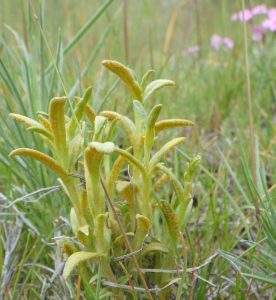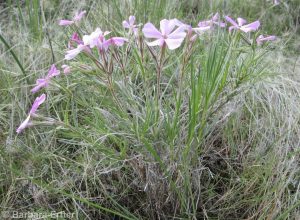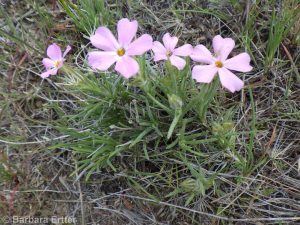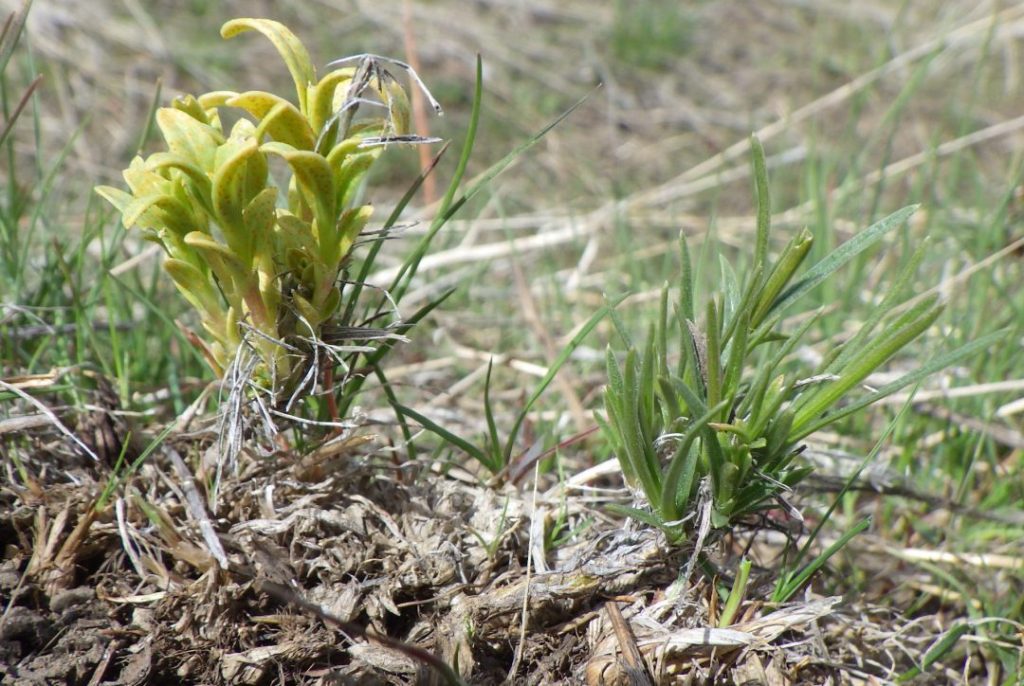With “zombie fungus” currently in the public eye, thanks to the popularity of “The Last of Us”, let me introduce you to a botanical counterpart that’s easily observed in the Boise Front in spring. As is so often the case, what nature comes up with can be more bizarre than what human minds could conceive of on their own, which is why we often turn to the natural world for inspiration in our fiction, and even our technology.
The two plants in this photo are in all likelihood different shoots of the same plant, connected by underground branches. The one on the right is a normal early-season shoot of phlox, either prickly-leaf phlox (Phlox aculeata) or long-leaf phlox (Phlox longifolia). The two closely related species are relatively distinct and easy to tell apart in the portions of their respective ranges that don’t overlap on one another, but a full gamut of morphological intermediates occurs in the Boise Front, and young shoots with leaves just developing are particularly problematic.
In contrast, the shoot on the left is so different that it appears to be an unrelated species, with much wider, yellowish leaves. These differences are caused by a rust fungus that has infected this shoot, hijacked its metabolic controls, and forced the plant to grow into a form that benefits this fungus, not the plant. I’m guessing the rust fungus in question is a species of Puccinia, though if there are any existing studies on this particular rust/flower combination, I’m not aware of them.
What intrigues me most is the similarity of the resultant morphology to a well-studied counterpart in some other genera, notably rockcresses (Boechera and Arabis). Rust–infected shoots in these genera terminate in conspicuous yellow clusters of modified leaves that not only look enough like flowers to attract flies and other pollinators, but can even produce fragrances and sugary nectars (see “Fungus Is a Flowerlike Con Artist“). It is probably no coincidence that these “pseudoflowers” can most often be found in early spring, when actual flowers are still in short supply, and when buttercups (Ranunculus) and other bright yellow flowers are particularly noticeable.

The set-up works great for the fungus, which takes advantage of the existing flower-pollinator collaborative system for dispersing its own spores. These spores, and usually(?) a sweet nectar, are produced in abundance in tiny cups on the undersides of the modified leaves. Flies, which are often the most abundant early spring pollinators, seem perfectly satisfied with the pseudoflower nectar, and may even prefer it over whatever the real flowers that are in bloom have to offer.
The loser, alas, is the poor infected plant itself. Not only is the modified shoot prevented from blooming, but even normal-looking adjacent shoots appear to be less likely to develop flowers, at least in the phlox I’ve been observing in the Boise Front. My guess is that energy and nutrients are diverted to the greedy zombie shoots via underground stems, depleting what would otherwise be available to the rest of the plant. It’s even possible that other spring-blooming species lose out, if pollinators are in short supply and preferentially visit the scamming pseudoflowers.
Of course, a major difference between zombies in pop culture, and zombie-esque fungi in real life, is that the latter don’t end up threatening the continued existence of the host species, either by directly killing them off or by simply disrupting their reproductive capacity. Any fungus or other parasite that wiped out its host species would end up wiping out itself, and while we can’t be certain this never happens, it does mean that any fungus so poorly adapted would quickly disappear after a very brief existence. In the case of phlox, although a few shoots in a population might be infected, and some individual plants weakened beyond recovery, the population itself generally continues just fine, blooming merrily away as the season progresses. And by peak bloom, the zombie shoots have often finished their fungal reproduction and disappeared, waiting to reappear in the sequel year.


